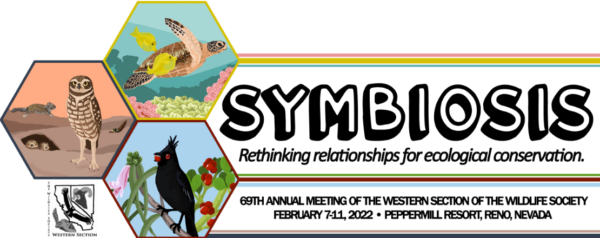 Poster presenters may choose to participate either in-person or virtually. ALL posters should be uploaded electronically by January 30th for virtual viewing. Yes, even posters that will be live in Reno should also be uploaded to Whova the week before the meeting. Thank you!
Poster presenters may choose to participate either in-person or virtually. ALL posters should be uploaded electronically by January 30th for virtual viewing. Yes, even posters that will be live in Reno should also be uploaded to Whova the week before the meeting. Thank you!
Note, physical display boards are limited so in-person presenters must reserve their space when they submit their abstract. To inquire about changing your participation mode, you may email projectmanager@tws-west.org.
- Review your abstract online and fix any HTML form/special character errors. All abstract edits are due by January 7, 2022. (Your personal edit link was sent via email as part of your abstract acceptance message.)
- All poster presenters must pay to register for the meeting by January 7, 2022.
- Prepare your poster:
- Document requirements: Max size is 48” x 44” Landscape – single page, landscape format. (48″x36″ is the standard size most people use.) Max PDF file size for Whova upload is 10 mb.
- Ideas to minimize PDF file size for PDF upload file: crop and compress images to optimal resolution of 100 dpi prior to place.
- Please be sure to add any necessary disclaimers to your poster or oral presentation (such as whether data presented is preliminary or proprietary) given the potential for the files to be screen captured in the virtual format. For example, you could add the following disclaimer to your presentation: “Please do not cite this presentation/poster. Instead refer to the references cited or contact the authors.”
- Make an Optional Video Presentation:
- Record yourself summarizing the research highlights in a 3-5 minute video, maybe even in front of a printed poster (think: in-person poster session) or using voice-over/computer-screen tools. Max video file size 200 mb.
- Set-up a Zoom meeting with yourself as the only participant. You may sign up for a free Zoom account at www.zoom.us. Share your screen, open up your poster file. This will allow for the poster to appear full screen with a picture of you/or your camera shot in the upper right hand corner. Click the record button. Tell us about your poster, stop recording. End Zoom meeting and the .mp4 file will be available on your computer (in the documents file) shortly after you finish the Zoom meeting.
- Upload a .pdf image of your poster to the Whova app by Sunday, January 30, 2022 at 11:59pm (PST). All presentations will be available to meeting registrants for advance, on-demand viewing starting a week before the meeting begins and for 6 months following the conference. See instructions below. You may make edits to your speaker page and upload files as often as you’d like.
Upload instructions:
- Login to the Whova speaker presenter platform using your personal and unique URL. Login credentials were emailed to you (at the email address used for meeting registration) on January 11, 2022 at 8:46am (check your spam folder if you can’t find the email) along with instructions for how to upload your presentation(s) to your speaker page in the Whova Event platform.
- You may update/edit/add your affiliation; your bio and profile photo. Edits may be made anytime, again and again so you may upload newer drafts of your poster whenever you’d like.
- In the documents session, upload any handouts that you’d like to share including your poster file. (PDF format, 10MB max file size.) Do not add your abstract as we already link to it automatically! Our file storage space in whova is limited.
- Please also upload your optional video presentation in this section. (MP4 format, 200MB max file size.)
- You may also add discussion topics, publications, url’s to articles, and any social media information you’d like to share. This is all optional though the discussion topics would be very helpful for engaging meeting participants virtually!
- Be sure to hit “SAVE” to make sure your information gets added, and you’ll also have to click “no” in the blue box so that your updates are saved.
By uploading your presentation to the Whova speaker page, you give TWS-WS the rights to upload/distribute the presentation to 2022 TWS-WS attendees through the Whova Event Platform.
- Interaction through a chat function on your Whova speaker page allows Q&A opportunities, and interaction between presenters and participants. Presenters should plan to respond to chat questions for at least one month following the end of the meeting to maximize professional development.
VIRTUAL POSTER PRESENTERS: Presenters participating virtually may send their printed posters to us if they’d like us to post it in Reno on their behalf. You may mail it to us directly, or send it to our Fedex printer (printing cost prepaid by the presenter). (Due February 3, 2022) We are not able to return posters though you are welcome to have a colleague pick up for you.
IN-PERSON POSTER PRESENTERS: For poster presenters participating in-person in Reno, a poster session and reception will be held Wednesday evening, February 9, 2022 from 6:30-8:30pm. Poster presenters must be available at their poster at this time to discuss their work with interested viewers. Hors d’ouevres will be served along with a no-host bar. In-person poster presenters will set up their posters at the Peppermill Resort (exhibit hall) on Wednesday (2/9/22) between 1-3pm. Display boards will be provided. Business cards or small leaflet literature for distribution may be inserted in an envelope and affixed to your poster. Posters should be no more than 48” wide by 44” tall Landscape . Poster viewing and judging will take place starting Wednesday, February 9 at 3pm through Thursday, February 10 at 7:00pm. Posters should be removed on Friday morning. Poster boards will be numbered and presenters should attach their posters to the board number corresponding to the number assigned to their posters. Board number assignments and confirmation of your setup time will be provided by the Poster Session Chairs a few weeks before the conference.
Poster Presentation Design Tips:
- The purpose of the poster is to convey highlights of your study in manner that can be easily read and understood in less than 5 minutes. Keep text brief – efficient use of limited words and images is necessary. It is not advisable to display the entire text from a manuscript. Too much detail detracts from the primary message of the text. Consider using bulleted phrases rather than complete sentences, where appropriate.
- A three column format fits best in landscape. The flow of the poster should be from the top to bottom of each column, and from the left column to right columns.
- Text and figures should be readable to someone standing six feet away. Adjust font and image sizes accordingly. BIG IS BEAUTIFUL and easy to read.
- Engage with graphics and interactive hyperlinks and/or QR codes to share your research in greater detail in this virtual format.
- Suggested font type and size
- Sans serif typeface, such as Arial, is best for good visibility at a distance; keep font type consistent throughout. Simple typefaces are preferable to fancy fonts. Bold type may be effective on headings.
- Title – 72 point or larger; keep it short and limited to one line.
- Authors’ names and affiliations – 48 point; limited to two lines.
- Section headings – 36 point.
- Text – 28 point.
- Graphs and tables – all numbers and labels 28 point or larger.
- Graph bars and symbols – use colors; avoid cross hatching.
- Acknowledgments – 20 to 24 point
- Use appropriate and compatible colors for fonts, backgrounds, graphics, and matting. Photographs and color should be used to enhance the attractiveness of the poster and to entice the audience to stop and read it. White or light pastel backgrounds are attractive and allow use of contrasting font colors, such as black, dark blue, and red. Use of photographs as backgrounds is not recommended, because legibility of text and graphics is usually compromised.
- Keep graphs and photos simple. Convey only one idea per graph, table, or photograph. Graphs are preferred over tables. Graphs need to be carefully designed so that they are readily comprehended and include captions. Details should be kept to a minimum. Figures from publications, theses, or dissertations normally do not make good visuals. Too much detail detracts from the primary message of the figure.
- Use appropriate blank space between words, sections, and figures. A blank space 1.5 inches wide between columns is best.
- Poster elements
- Title
- Authors’ names and affiliations appear below the title.
- Abstract (optional)
- Introduction: limit to a few statements and clearly state study objectives.
- Methods or Experimental Design: keep text minimal, use graphics where possible.
- Results: this section should take up most of the space; keep statements brief.
- Conclusions: limit this section to a few bulleted statements or brief paragraph.
- Acknowledgments: include when appropriate; limit to a few statements.
We recommend the following resource which offers great suggestions on how to improve your poster presentation: http://betterposters.blogspot.com/
Please note: We will not accept last minute substitutions or allow posters to be presented that were not part of the submittal process. No live animals, please.
